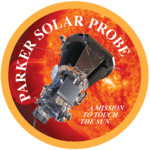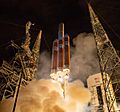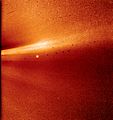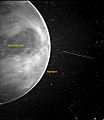Parker Solar Probe facts for kids

Artistic rendition of the Parker Solar Probe.
|
|
| Names | Solar Probe (before 2002) Solar Probe Plus (2010–17) Parker Solar Probe (since 2017) |
|---|---|
| Mission type | Heliophysics |
| Operator | NASA · Applied Physics Laboratory |
| Mission duration | Planned: 6 years, 321 days |
| Spacecraft properties | |
| Manufacturer | Applied Physics Laboratory |
| Launch mass | 685 kg (1,510 lb) |
| Dry mass | 555 kg (1,224 lb) |
| Payload mass | 50 kg (110 lb) |
| Dimensions | 1.0 m × 3.0 m × 2.3 m (3.3 ft × 9.8 ft × 7.5 ft) |
| Power | 343 W (at closest approach) |
| Start of mission | |
| Launch date | August 12 07:31 UTC, 2018 |
| Rocket | Delta IV Heavy / Star-48BV |
| Launch site | Cape Canaveral SLC-37 |
| Contractor | United Launch Alliance |
| Orbital parameters | |
| Reference system | Heliocentric |
| Perihelion | 0.044 AU (6.6 million km; 4.1 million mi; 9.5 R☉) |
| Aphelion | 0.73 AU (109 million km; 68 million mi) |
| Inclination | 3.4° |
| Period | 88 days |
| Sun | |
 Official insignia for the Parker Solar Probe mission |
|
Parker Solar Probe is a NASA robotic spacecraft heading towards the outer corona of the Sun. It will reach to within 8.86 solar radii (6.2 million kilometers or 3.85 million miles) from the "surface" of the Sun and will travel, at closest approach, as fast as 700,000 km/h (430,000 mph).
It was launched on August 12, 2018. This was the first time a NASA spacecraft was named after a living person, honoring physicist Eugene Parker.
A memory card having the names of over 1.1 million people was mounted on a plaque and installed below the spacecraft’s high-gain antenna on May 18, 2018.
The card also contains photos of Parker, professor emeritus at the University of Chicago, and a copy of his 1958 scientific paper.
Timeline
After the first Venus fly-by, the probe will be in an elliptical orbit with a period of 150 days (two-thirds the period of Venus), making three orbits while Venus makes two. On the second fly-by, the period shortens to 130 days. After less than two orbits (only 198 days later) it encounters Venus a third time at a point earlier in the orbit of Venus. This encounter shortens its period to half of that of Venus, or about 112.5 days. After two orbits it meets Venus a fourth time at about the same place, shortening its period to about 102 days. After 237 days it meets Venus for the fifth time and its period is shortened to about 96 days, three-sevenths that of Venus. It then makes seven orbits while Venus makes three. The sixth encounter, almost two years after the fifth, brings its period down to 92 days, two-fifths that of Venus. After five more orbits (two orbits of Venus) it meets Venus for the seventh and last time, decreasing its period to 88 or 89 days and allowing it to approach closer to the Sun.
| Year | Events | |||||||||||||
|---|---|---|---|---|---|---|---|---|---|---|---|---|---|---|
| Jan | Feb | Mar | Apr | May | Jun | Jul | Aug | Sep | Oct | Nov | Dec | |||
| 2018 | Aug 12 Launch |
Sep 28 First flyby of Venus (period 150 days) |
Nov 1 Perihelion #1 |
|||||||||||
| 2019 | Mar 31 Perihelion #2 |
Aug 28 Perihelion #3 |
Dec 21 Second flyby of Venus (period 130 days) |
|||||||||||
| 2020 | Jan 24 Perihelion #4 |
Jun 2 Perihelion #5 |
Sep 22 Perihelion #6 |
|||||||||||
| Jul 6 Third flyby of Venus (period 112.5 days) |
||||||||||||||
| 2021 | Jan 13 Perihelion #7 |
Apr 24 Perihelion #8 |
Aug 5 Perihelion #9 |
Nov 16 Perihelion #10 |
||||||||||
| Feb 16 Fourth flyby of Venus (period 102 days) |
Oct 11 Fifth flyby of Venus (period 96 days) |
|||||||||||||
| 2022 | Feb 21 Perihelion #11 |
May 28 Perihelion #12 |
Sep 1 Perihelion #13 |
Dec 6 Perihelion #14 |
||||||||||
| 2023 | Mar 13 Perihelion #15 |
Jun 17 Perihelion #16 |
Sep 23 Perihelion #17 |
Dec 24 Perihelion #18 |
||||||||||
| Aug 16 Sixth flyby of Venus (period 92 days) |
||||||||||||||
| 2024 | Mar 25 Perihelion #19 |
Jun 25 Perihelion #20 |
Sep 25 Perihelion #21 |
Dec 19 Perihelion #22 First close approach to the Sun |
||||||||||
| Nov 2 Seventh flyby of Venus (period 88 days) |
||||||||||||||
| 2025 | Mar 18 Perihelion #23 |
Jun 14 Perihelion #24 |
Sep 10 Perihelion #25 |
Dec 7 Perihelion #26 |
||||||||||
Images for kids
-
Photo from the WISPR shows a coronal streamer, seen over the east limb of the Sun on Nov. 8, 2018, at 1:12 a.m. EST. The fine structure of the streamer is very clear, with at least two rays visible. Parker Solar Probe was about 16.9 million miles from the Sun's surface when this image was taken. The bright object near the center of the image is Mercury, and the dark spots are a result of background correction.
-
Photo taken by the probe during its second Venus flyby, July 2020
See also
 In Spanish: Sonda Solar Parker para niños
In Spanish: Sonda Solar Parker para niños














